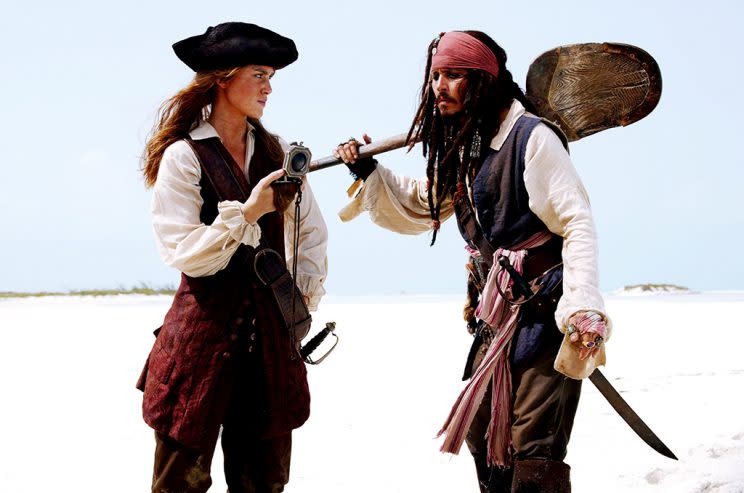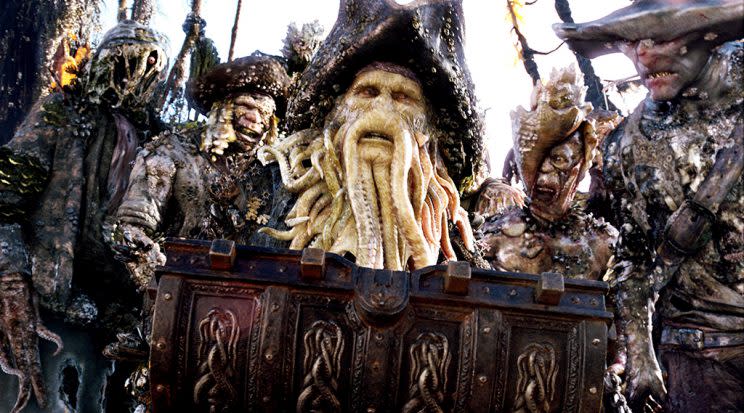Our Defense of the (First Two) 'Pirates of the Caribbean' Sequels

By Oliver Lyttelton
This Friday brings the return of one of the biggest franchises around with Pirates of the Caribbean: Dead Men Tell No Tales, the fifth film in the series based on the Disney theme park ride. It’s been six years since Johnny Depp’s Captain Jack Sparrow last set sail, and it’s hoped that the new film will serve as a return to form for him and the series. While the 2003 original is deemed a classic, the sequels were mostly poorly received by critics, and to some extent, fans. But at least as far as the first two follow-ups go, we’d argue that there’s a lot to love.
Back in 2003, director Gore Verbinski’s Pirates of the Caribbean: The Curse of the Black Pearl had proved a surprise smash. Expectations were low for the project: Films about pirates traditionally tanked at the box office (1995’s flop Cutthroat Island being the most recent example), and star Depp was better known as a quirky character actor than a blockbuster leading man. Indeed, the studio was nervous: After their first theme-park-ride adaptation The Country Bears flopped in 2002, Disney nearly scrapped the movie, and Depp himself would later say that executives believed that his foppish, offbeat performance as Sparrow was “ruining” the film.
Watch a trailer for ‘Dead Man’s Chest:’
But in the end, critics and audiences loved the movie: reviews were great (“the best spectacle of the summer,” wrote The New Yorker of all places), box office stellar, with $650 million taken worldwide, and the film even picked up five Oscar nominations, including a Best Actor nod for Depp. Unsurprisingly, a sequel was quickly greenlit. In fact, not just one — two sequels, with Verbinski again at the helm.
With trilogies like The Lord of the Rings all the rage at the time, the ambitious plan was to shoot two films back-to-back, released a year apart and with vast budgets — $450 million between the pair. The story saw Captain Jack (Depp) reunited with old comrades Will Turner (Orlando Bloom) and Elizabeth Swann (Keira Knightley) to take on the tentacle-faced Davy Jones (Bill Nighy), though many twist and turns would unfold over the following two movies.

The films certainly lived up to financial hopes: 2006’s Dead Man’s Chest had the biggest opening weekend of all time up to that point, and became the fastest film (and only the third ever) to make a billion dollars, while 2007’s At World’s End, did only slightly less. But on the whole, the films weren’t greeted with the same enthusiasm as their predecessor.
The two films received poorer reviews than the original, with 54 percent and 45 percent, respectively, at Rotten Tomatoes. And while many critics were merely disappointed, some reviews were toxic. “A hellish contraption into which a ticket holder is strapped, overstimulated but unsatisfied,” wrote Entertainment Weekly of the first sequel, while At World’s End was savaged even further: “[a] bloated, overwrought and convoluted three-hour misfire,” wrote USA Today.
Watch a trailer for ‘At World’s End:’
As a result, the Pirates franchise has come to be seen by some as emblematic of the worst of the modern franchise-focused, sequel-obsessed studio system. (Why The ‘Pirates of the Caribbean’ Sequels Are Everything That’s Wrong With Hollywood, went one recent Bustle post). But rewatching the films recently, we found them hard to hate.
There’s plenty wrong with them, for sure. With a total running time of over five hours, they’re bloated, over-plotted (the various side-swaps and betrayals start to feel like busy-work), and succumb to a sense of CGI fatigue that Verbinski’s first film never did. But they’re also eccentric, thrillingly made, genuinely involving films, and a lot more distinctive and enjoyable than many blockbusters today.

The sequels expand the Pirates universe into one as rich and fascinating as a Star Wars or Marvel world, whether through the production design, the mythology of the pirate council and the different nations that make it up, or most crucially, in the beautifully-designed fish-monster bad guys. Nighy’s villainous Davy Jones, a CGI construction, remains a high watermark for digital performance capture characters even 10 years later. He never feels like anything but a real flesh-and-blood creature (thanks in part to Nighy’s textured, complex performance).
Verbinski doesn’t get much respect from cinephiles as a director, but he has a beautiful eye and a strong feel for tone, melding Gothic creepiness with almost Monty Python-esque absurdist humor (including a deeply odd section in the third movie where Captain Jack interacts with a crew full of himself.) And while his action sequences here can go a bit overlong, they’re also terrifically constructed, with a strong sense of geography, an ability to juggle tension on multiple fronts, and a Spielbergian facility for memorable beats and gags.
We wouldn’t pass most of these compliments onto the fourth film, 2011’s On Stranger Tides, a badly-executed sequel directed by Rob Marshall that gets very wrong almost everything of what Verbinski got right. But whatever their reputation, we remain resolute defenders of Dead Man’s Chest and At World’s End. Here’s hoping this weekend’s Dead Men Tell No Tales is half as weird, inventive or ambitious.
Read more from Yahoo Movies:
